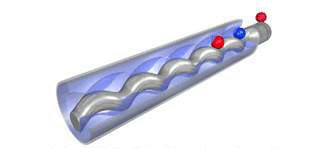Information about this type
Displacement pumps
Worm pumps are a type of positive displacement pump used to move viscous and thick liquids. They are ideal for applications where centrifugal pumps are ineffective, such as when moving honey, paint, toothpaste, or even liquid manure.
A worm pump consists of a cylindrical housing and a worm screw that rotates inside. The worm screw is shaped like a helical screw, which moves the fluid along the threads of the screw as it rotates in the housing. This continuously moves the fluid from the inlet to the outlet of the pump.
Worm pumps have a number of advantages over other pump types, such as higher efficiency when moving viscous liquids and a smooth, pulse-free flow. However, they are less suitable for moving liquids at a high flow rate due to the limited throughput.
Overall, worm pumps provide a reliable and cost-effective solution for moving thick liquids in a variety of applications and industries.
AdviceHow does a progressive cavity pump work?
For the operation of the pump, there are two important parts, namely the rotor and the stator. These parts ensure flawless operation of the progressive cavity pump. The rotor is always located in the stator and will create spaces through the rotating movement through which the medium will be pumped.
Rotor
The rotor is screw-shaped and has a circular cross-section, which is one of the reasons why the rotor has an important function.
Stator
The stator has a helical bore, which creates spaces when the helical rotor rotates. The medium to be pumped can be carried along in the direction of the discharge side through these spaces.
